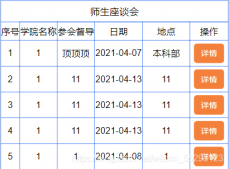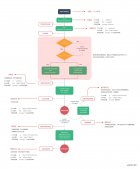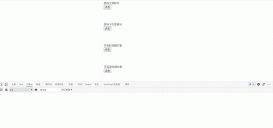组件基础
1 组件的复用
组件是可复用的Vue实例。
|
1
2
3
4
5
6
7
8
9
10
11
12
13
14
15
16
17
18
19
20
21
22
23
24
25
26
27
28
29
30
|
<!DOCTYPE html><html> <head> <meta charset="utf-8"> <style> </style> </head> <body> <div id="app"> <button-counter></button-counter> <button-counter></button-counter> <button-counter></button-counter> </div> <script> // 定义一个名为 button-counter 的新组件 Vue.component('button-counter', { data: function () { return { count: 0 } }, template: '<button v-on:click="count++">点击了 {{ count }} 次.</button>' }); new Vue({ el: '#app' }); </script> </body></html> |
注意当点击按钮时,每个组件都会各自独立维护它的count。这里自定义组件的data属性必须是一个函数,每个实例维护一份被返回对象的独立的拷贝。
|
1
2
3
4
5
6
7
8
9
10
11
12
13
14
15
16
17
18
19
20
21
22
23
24
25
26
27
28
29
30
31
|
<!DOCTYPE html><html> <head> <meta charset="utf-8"> <style> </style> <script src="https://cdn.staticfile.org/vue/2.4.2/vue.min.js"></script> </head> <body> <div id="app"> <button-counter></button-counter> <button-counter></button-counter> <button-counter></button-counter> </div> <script> var buttonCounterData = { count: 0 } // 定义一个名为 button-counter 的新组件 Vue.component('button-counter', { data: function () { return buttonCounterData }, template: '<button v-on:click="count++">点击了 {{ count }} 次.</button>' }); new Vue({ el: '#app' }); </script> </body></html> |
2 通过 Prop 向子组件传递数据
|
1
2
3
4
5
6
7
8
9
10
11
12
13
14
15
16
17
18
19
20
21
22
23
24
25
|
<!DOCTYPE html><html> <head> <meta charset="utf-8"> <style> </style> <script src="https://cdn.staticfile.org/vue/2.4.2/vue.min.js"></script> </head> <body> <div id="app"> <blog-post title="My journey with Vue"></blog-post> <blog-post title="Blogging with Vue"></blog-post> <blog-post title="Why Vue is so fun"></blog-post> </div> <script> Vue.component('blog-post', { props: ['title'], template: '<h3>{{ title }}</h3>' }) new Vue({ el: '#app' }); </script> </body></html> |
这里<blog-post>组件就是通过自定义属性title来传递数据。
我们可以使用v-bind来动态传递prop。
|
1
2
3
4
5
6
7
8
9
10
11
12
13
14
15
16
17
18
19
20
21
22
23
24
25
26
27
28
29
30
31
32
|
<!DOCTYPE html><html> <head> <meta charset="utf-8"> <style> </style> <script src="https://cdn.staticfile.org/vue/2.4.2/vue.min.js"></script> </head> <body> <div id="app"> <blog-post v-for="post in posts" v-bind:key="post.id" v-bind:title="post.title"></blog-post> </div> <script> Vue.component('blog-post', { props: ['title'], template: '<h3>{{ title }}</h3>' }) new Vue({ el: '#app', data: { posts: [ { id: 1, title: 'My journey with Vue' }, { id: 2, title: 'Blogging with Vue' }, { id: 3, title: 'Why Vue is so fun' } ] } }); </script> </body></html> |
3 单个根元素
每个组件必须只有一个根元素。
|
1
2
3
4
5
6
7
8
9
10
11
12
13
14
15
16
17
18
19
20
21
22
23
24
25
26
27
28
29
30
31
32
33
34
35
36
37
|
<!DOCTYPE html><html> <head> <meta charset="utf-8"> <style> </style> <script src="https://cdn.staticfile.org/vue/2.4.2/vue.min.js"></script> </head> <body> <div id="app"> <blog-post v-for="post in posts" v-bind:key="post.id" v-bind:post="post"></blog-post> </div> <script> Vue.component('blog-post', { props: ['post'], template: ` <div class="blog-post"> <h3>{{ post.title }}</h3> <div v-html="post.content"></div> </div> ` }) new Vue({ el: '#app', data: { posts: [ { id: 1, title: 'My journey with Vue', content: 'my journey...' }, { id: 2, title: 'Blogging with Vue', content: 'my blog...' }, { id: 3, title: 'Why Vue is so fun', content: 'Vue is so fun...' } ] } }); </script> </body></html> |
注意到v-bind:post="post"绑定的post是一个对象,这样可以避免了需要通过很多prop传递数据的麻烦。
4 监听子组件事件
|
1
2
3
4
5
6
7
8
9
10
11
12
13
14
15
16
17
18
19
20
21
22
23
24
25
26
27
28
29
30
31
32
33
34
35
36
37
38
39
40
41
42
43
44
|
<!DOCTYPE html><html> <head> <meta charset="utf-8"> <style> </style> <script src="https://cdn.staticfile.org/vue/2.4.2/vue.min.js"></script> </head> <body> <div id="app"> <div :style="{fontSize: postFontSize + 'em'}"> <blog-post v-for="post in posts" v-bind:key="post.id" v-bind:post="post" v-on:enlarge-text="postFontSize += 0.1" /> </div> </div> <script> Vue.component('blog-post', { props: ['post'], template: ` <div class="blog-post"> <h3>{{ post.title }}</h3> <button v-on:click="$emit('enlarge-text')">放大字体</button> <div v-html="post.content"></div> </div> ` }) new Vue({ el: '#app', data: { postFontSize: 1, posts: [ { id: 1, title: 'My journey with Vue', content: 'my journey...' }, { id: 2, title: 'Blogging with Vue', content: 'my blog...' }, { id: 3, title: 'Why Vue is so fun', content: 'Vue is so fun...' } ] } }); </script> </body></html> |
子组件通过$emit方法并传入事件名称来触发一个事件。父组件可以接收该事件。
我们可以使用事件抛出一个值。
|
1
2
3
4
5
6
7
8
9
10
11
12
13
14
15
16
17
18
19
20
21
22
23
24
25
26
27
28
29
30
31
32
33
34
35
36
37
38
39
40
41
42
43
44
|
<!DOCTYPE html><html> <head> <meta charset="utf-8"> <style> </style> <script src="https://cdn.staticfile.org/vue/2.4.2/vue.min.js"></script> </head> <body> <div id="app"> <div :style="{fontSize: postFontSize + 'em'}"> <blog-post v-for="post in posts" v-bind:key="post.id" v-bind:post="post" v-on:enlarge-text="postFontSize += $event" /> </div> </div> <script> Vue.component('blog-post', { props: ['post'], template: ` <div class="blog-post"> <h3>{{ post.title }}</h3> <button v-on:click="$emit('enlarge-text', 0.2)">放大字体</button> <div v-html="post.content"></div> </div> ` }) new Vue({ el: '#app', data: { postFontSize: 1, posts: [ { id: 1, title: 'My journey with Vue', content: 'my journey...' }, { id: 2, title: 'Blogging with Vue', content: 'my blog...' }, { id: 3, title: 'Why Vue is so fun', content: 'Vue is so fun...' } ] } }); </script> </body></html> |
在父组件中,我们可以通过$event访问到被抛出的这个值。
我们可以在组件上使用v-model。
|
1
2
3
4
5
6
7
8
9
10
11
12
13
14
15
16
17
18
19
20
21
22
23
24
25
26
27
28
29
30
31
32
33
34
35
36
37
38
39
40
41
42
43
44
45
46
47
48
49
50
51
52
53
54
55
|
<!DOCTYPE html><html> <head> <meta charset="utf-8"> <style> </style> <script src="https://cdn.staticfile.org/vue/2.4.2/vue.min.js"></script> </head> <body> <div id="app"> <!-- <input v-model="searchText"> --> <input v-bind:value="searchText" v-on:input="searchText = $event.target.value"> <p>{{ searchText }}</p> </div> <script> new Vue({ el: '#app', data: { searchText: '' } }); </script> </body></html><!DOCTYPE html><html> <head> <meta charset="utf-8"> <style> </style> <script src="https://cdn.staticfile.org/vue/2.4.2/vue.min.js"></script> </head> <body> <div id="app"> <custom-input v-model="searchText"></custom-input> <custom-input v-bind:value="searchText" v-on:input="searchText = $event"></custom-input> <p>{{ searchText }}</p> </div> <script> Vue.component('custom-input', { props: ['value'], template: `<input v-bind:value="value" v-on:input="$emit('input', $event.target.value)" >` }) new Vue({ el: '#app', data: { searchText: '' } }); </script> </body></html> |
最后,注意解析 DOM 模板时的注意事项。
以上就是vue 组件基础知识总结的详细内容,更多关于vue 组件的资料请关注服务器之家其它相关文章!
原文链接:https://www.cnblogs.com/gzhjj/p/11769893.html

















